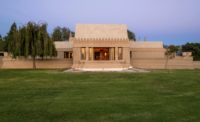A Frank Lloyd Wright Landmark Gets a Modern Pavilion by Mori
A new Toshiko Mori-designed visitor center is opening on March 18 at the Darwin D. Martin House complex in Buffalo, New York.

A Frank Lloyd Wright Landmark Gets a Modern Pavilion by Mori
A new Toshiko Mori-designed visitor center is opening on March 18 at the Darwin D. Martin House complex in Buffalo, New York..
Photo courtesy Toshiko Mori

A Frank Lloyd Wright Landmark Gets a Modern Pavilion by Mori
A southeast view of the new visitor center.
Photo © Biff Henrich/Darwin D. Martin House

A Frank Lloyd Wright Landmark Gets a Modern Pavilion by Mori
An interior shot of the new visitor center, facing the Darwin D. Martin House.
Photo © Biff Henrich/Darwin D. Martin House

A Frank Lloyd Wright Landmark Gets a Modern Pavilion by Mori
View of the Darwin D. Martin House. The house is undergoing a major restoration overseen by Hamilton Houston Lownie Architects, based in Buffalo.
Photo © Biff Henrich/Darwin D. Martin House

A Frank Lloyd Wright Landmark Gets a Modern Pavilion by Mori
View of the carriage house at the Darwin D. Martin House complex.
Photo © Biff Henrich/Darwin D. Martin House

A Frank Lloyd Wright Landmark Gets a Modern Pavilion by Mori
Archival photograph of the Darwin D. Martin House, circa 1910.
Photo courtesy Darwin D. Martin House




Post a comment to this article
Report Abusive Comment